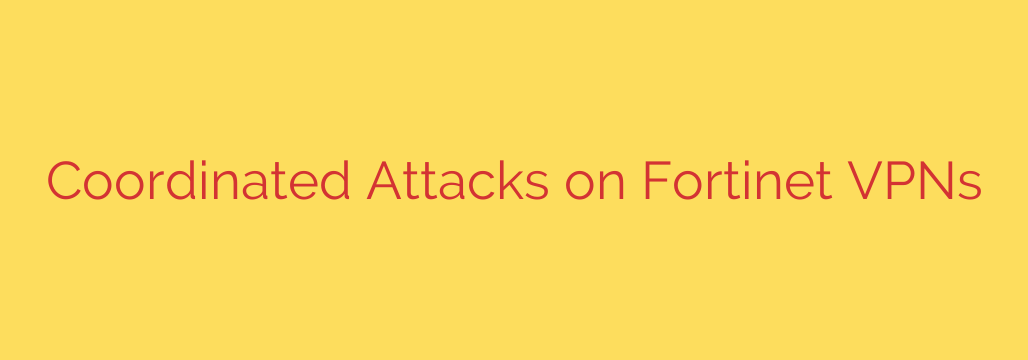
Urgent Security Alert: Coordinated Attacks Targeting Fortinet VPNs
Cybersecurity teams are on high alert as a new wave of sophisticated and coordinated attacks is actively targeting organizations using Fortinet VPNs. Threat actors are leveraging a multi-pronged strategy to breach corporate networks, combining technical exploits with targeted social engineering to gain unauthorized access.
This isn’t a simple, automated attack; it’s a calculated campaign designed to bypass security controls and establish a persistent foothold within target environments. Understanding the attack methodology is the first step toward building a robust defense.
Unpacking the Attack Methodology
The recent attacks are particularly dangerous because they don’t rely on a single point of failure. Instead, attackers chain together several techniques to maximize their chances of success.
Exploitation of Known Vulnerabilities: The primary entry point for many of these attacks is the exploitation of known, and in some cases, recently patched vulnerabilities in FortiGate devices. Attackers are actively scanning for unpatched systems to gain initial access to the network perimeter.
Targeted Social Engineering and MFA Fatigue: Once they have a list of valid user credentials, often acquired from other data breaches, attackers initiate a relentless “MFA Bombing” or “MFA Fatigue” attack. They bombard the legitimate user with dozens or even hundreds of push notifications from their multi-factor authentication (MFA) app. The goal is to annoy or confuse the user into accidentally approving a login request, thereby granting the attacker full access.
Credential Stuffing: In parallel, threat actors are using credential stuffing techniques. They take lists of usernames and passwords stolen from other breaches and systematically try them against the Fortinet VPN login portal. Any user who has reused a password from another compromised service is at extreme risk.
Once inside, attackers move quickly to escalate privileges, disable security software, and deploy ransomware or exfiltrate sensitive data. The speed and coordination of these attacks indicate that they are being carried out by well-organized and persistent threat groups.
Actionable Steps to Secure Your Fortinet VPN Immediately
Protecting your organization requires immediate and decisive action. A passive defense is not enough. The following steps are critical to mitigating this threat and hardening your network security posture.
Apply Security Patches NOW: This is the single most important step. Ensure that all of your FortiGate and other Fortinet appliances are running the latest version of FortiOS. Prioritize patching any vulnerabilities that allow for remote code execution or unauthorized access. Do not assume your systems are patched; verify it.
Strengthen Your Multi-Factor Authentication (MFA): Basic MFA is no longer sufficient to stop determined attackers. Move away from simple push-notification approvals and implement more phishing-resistant MFA methods. Options like number matching, where a user must enter a number displayed on the login screen into their authenticator app, are significantly more secure against MFA fatigue attacks.
Review and Audit VPN Access Logs: Diligently monitor your VPN logs for any signs of suspicious activity. Look for red flags such as:
- Multiple failed login attempts from a single user account.
- Logins from unusual or impossible geographic locations.
- Logins occurring at odd hours.
- A series of failed MFA attempts followed by a successful one.
Enforce Strong Password Policies and User Education: A strong password policy is a foundational element of security. Mandate the use of long, complex, and unique passwords for all user accounts, especially those with VPN access. Furthermore, educate your employees about the dangers of MFA fatigue attacks. Instruct them to never approve an MFA request they did not initiate and to immediately report any suspicious login activity to your IT or security team.
A Proactive Defense is Your Best Strategy
The threat landscape is constantly evolving, and these coordinated attacks on Fortinet VPNs are a stark reminder that network perimeter security is more critical than ever. The combination of technical exploits and clever social engineering means that a multi-layered defense is essential.
By immediately patching vulnerabilities, strengthening authentication protocols, actively monitoring logs, and educating users, you can significantly reduce your organization’s risk profile. Don’t wait for a breach to happen. Review your security posture today and take the necessary steps to protect your critical assets.
Source: https://heimdalsecurity.com/blog/fortinet-vpns-under-attack/








